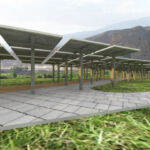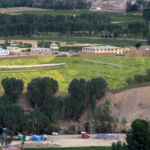Bamiyan Cultural Centre - Yereem & Associates
Project's Summary
The Bamiyan Cultural Centre, conceived by Yereem & Associates, represents a landmark fusion of environmental sustainability and cultural enrichment. Nestled in the historical region of Bamiyan, Afghanistan, this architectural masterpiece is designed with a profound respect for the surrounding landscape and the rich cultural heritage of the area. The project is rooted in the idea of cultivating a harmonious space where visitors can connect with the local culture while enjoying a sustainable environment.

In crafting the centre, the architects prioritized sustainability through the innovative use of natural daylight. The building's roof is meticulously designed to capture optimal sun angles, ensuring that interior spaces are bathed in natural light throughout the day. This approach not only minimizes the reliance on artificial lighting but also enhances the overall visitor experience, creating a warm and inviting atmosphere. Moreover, the selection of building materials underscores the commitment to sustainability, with an emphasis on locally sourced resources such as bricks, mud, and cement, promoting economic growth in the community.

A central element of the Bamiyan Cultural Centre's design is the thoughtfully integrated courtyard. This outdoor space serves as a transitional area where visitors can gather before entering the various functional spaces, including exhibition halls, classrooms, and research facilities. The courtyard significantly improves ventilation within the building, contributing to a comfortable climate for all users. Furthermore, it acts as a social hub, encouraging interaction and dialogue among visitors, thereby fostering community ties and cultural exchange.

Incorporating renewable energy solutions, the centre features solar panels that not only provide electricity for its operations but also enhance the landscape design. Strategically placed in key areas such as the parking lot and drop-off zone, these panels offer shade and comfort for visitors while highlighting the centre's commitment to sustainability. The hot and arid climate of Bamiyan, characterized by over six hours of sunlight daily, allows these solar installations to generate sufficient energy to meet both the centre's and the local community's needs.
In conclusion, the Bamiyan Cultural Centre stands as a testament to the power of thoughtful architectural design. Yereem & Associates have successfully woven together the threads of environmental stewardship and cultural engagement, creating a space that not only meets functional requirements but also serves as a beacon of hope and inspiration for the local community. This project exemplifies how architecture can play a pivotal role in promoting sustainability and cultural appreciation, paving the way for future developments in harmony with the environment.
Read also about the East 90th Street Apartment Renovation | Balestri Architects project



